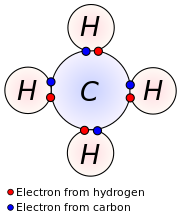
In chemistry and physics, valence electrons are electrons in the outermost shell of an atom, and that can participate in the formation of a chemical bond if the outermost shell is not closed. In a single covalent bond, a shared pair forms with both atoms in the bond each contributing one valence electron.
The presence of valence electrons can determine the element's chemical properties, such as its valence—whether it may bond with other elements and, if so, how readily and with how many. In this way, a given element's reactivity is highly dependent upon its electronic configuration. For a main-group element, a valence electron can exist only in the outermost electron shell; for a transition metal, a valence electron can also be in an inner shell.
An atom with a closed shell of valence electrons (corresponding to a noble gas configuration) tends to be chemically inert. Atoms with one or two valence electrons more than a closed shell are highly reactive due to the relatively low energy to remove the extra valence electrons to form a positive ion. An atom with one or two electrons fewer than a closed shell is reactive due to its tendency either to gain the missing valence electrons and form a negative ion, or else to share valence electrons and form a covalent bond.
Similar to a core electron, a valence electron has the ability to absorb or release energy in the form of a photon. An energy gain can trigger the electron to move (jump) to an outer shell; this is known as atomic excitation. Or the electron can even break free from its associated atom's shell; this is ionization to form a positive ion. When an electron loses energy (thereby causing a photon to be emitted), then it can move to an inner shell which is not fully occupied.